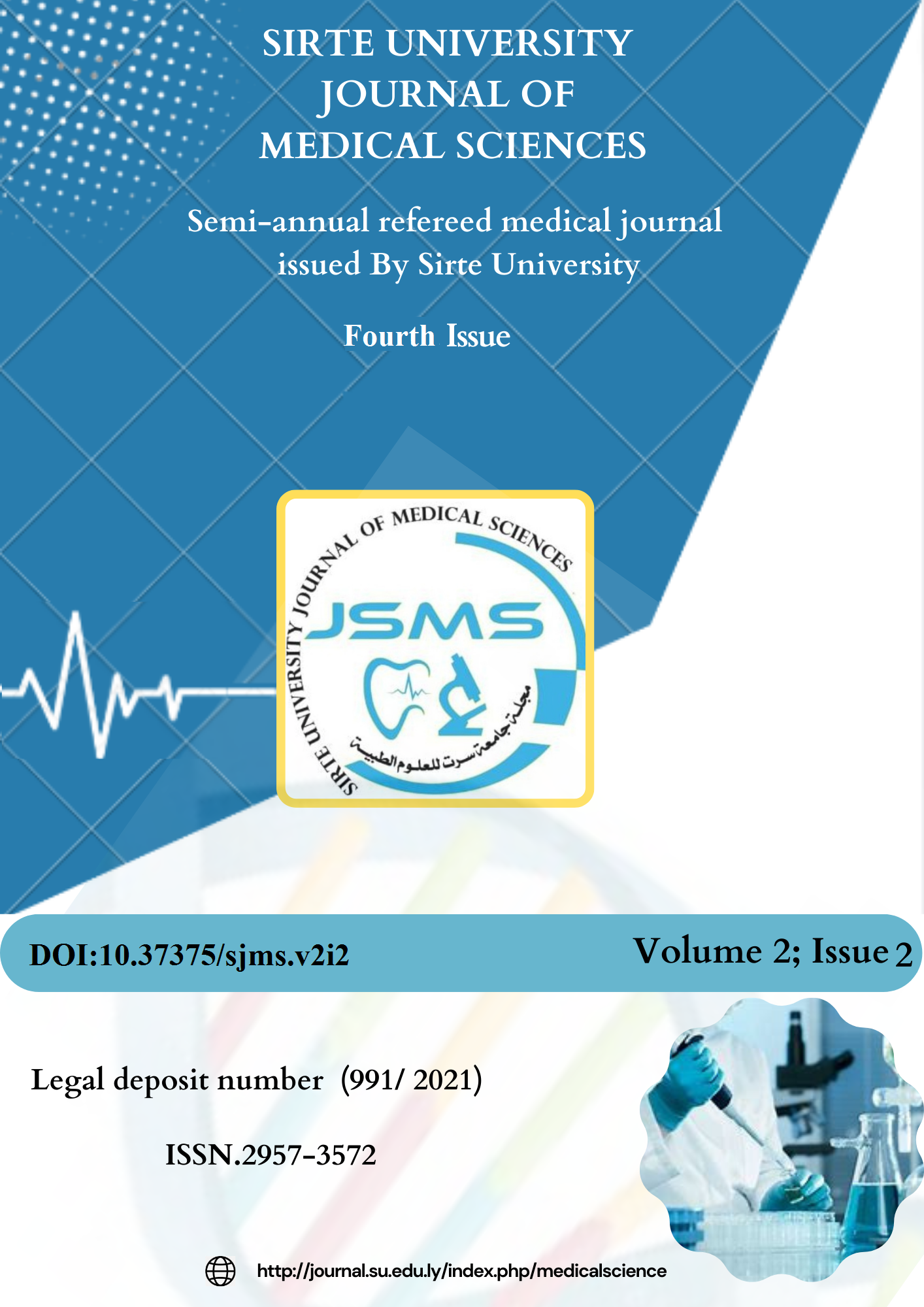Cesarean Scar Ectopic Pregnancy: Experience From Benghazi Medical Center, 2022
DOI:
https://doi.org/10.37375/sjms.v2i2.2532Keywords:
caesarean scar pregnancy (CSP ), ectopic pregnancy, hysterectomy, methotrexateAbstract
Background: Cesarean scar pregnancy (CSP) is a rare consequence of a previous cesarean delivery and a new type of ectopic pregnancy, but it is life-threatening if unrecognized and inadequately managed. Despite the rising incidence of CSP, there are no consensus or evidence-based guidelines for management. Aims: To review risk factors, clinical features, diagnostic methods, and management of women with CSP at Benghazi Medical Center. Materials and methods: A descriptive-case series study of CSP cases between the Ist of March 2018 and Ist of April 2022.. Data collected retrospectively. The data included demographics, presenting symptoms and signs, ultrasound findings, treatment used, and any complications. Results: The total number of ectopic pregnancies in period between 1st March 2018 and 1st April 2022 was 262, ten women (3.82%) were diagnosed as scar ectopic, The women's ages ranged from 28 to 47 years, about 60% had three or four previous cesarean scars, abdominal pain with vaginal bleeding was in 30% of the cases, while 60% of patients were asymptomatic and all patients were stable during the diagnosis, except for one case that had signs of shock. ultrasound finding was 80% presence of gestational sac implanted low near the previous scar; initial diagnosis was delayed by 50%. The management was laparotomy and gestational sac excision in four cases that did not require further treatment, dilatation and uterine evacuation were done in two cases that required use of uterine balloon to control bleeding and further use of methotrexate In one case (10%), systemic methotrexate alone was effective. Severe bleeding was seen among 60% of women, and 20% underwent hysterectomy. The complications were significantly (P< 0.05) more common among women with high parity and also in cases where there was no intervention during the diagnosis. Conclusion: A previous uterine scar is the main risk factor for CSP; there is no specific clinical feature for CSP; ultrasound is used for the diagnosis; surgical management appears to be a better option, serious complications were seen mainly when no intervention was done during the diagnosis.
References
Alkatout, I. et al. (2013)’Clinical diagnosis and treatment of ectopic pregnancy’, ObstetGynecolSurv; 68 (8): 571–581.
Arin, M.Buresch.et al. (2014) ‘Use and value of ultrasound in diagnosing cesarean scar pregnancy: a report of three cases’, J Reprod Med;59(9-10):517-21.
Boza, A. Boza ,B. and Murat A.(2016)’Cesarean Scar Pregnancy Managed with Conservative Treatment’,Iran J Med Sci; 41: 450–455.
Birch Petersen, K. et al. (2016) ‘Cesarean scar pregnancy: a systemic review of treatment studies’,FertilSteril; 105:958–67. Darwish, HS.Habash, YH.and Habash MY.(2020) ‘Ectopic pregnancies in caesarean section scars: 5 years experience’, Clinical Image;66.26-34.
D’Antonio, F. et al (2016)’Counseling in fetal medicine: evidence-based answers to clinical questions on morbidly adherent placenta’, Ultrasound Obstet Gynecol;47: 290 – 301.
Doroszewska, K. et al. (2019)’Cesarean scar pregnancy — various methods of treatment’,Folia Med Cracov;59(2):5-14. FulyaCagli et al.(2023) ‘Is local methotrexate therapy effective in the treatment of cesarean scar pregnancy? A retrospective cohort study’,J ObstetGynaecol Res ;49(1):122-127.
Gao, L. et al. (2018)’A retrospective comparative study evaluating the efficacy of adding intra-arterial methotrexate infusion to uterine artery embolisation followed by curettage for cesarean scar pregnancy’,Arch. Gynecol. Obstet;297, 1205–1211. Gerday, A.et al.(2020).
‘Experience With Medical Treatment of Cesarean Scar Ectopic Pregnancy (CSEP) With Local Ultrasound-Guided Injection of Methotrexate’,Front Med (Lausanne); Nov 3;7:564764.
Glenn, TL. et al.(2018) ‘Cesarean scar ectopic pregnancy: current management strategies’,Obstetrical & gynecological survey;73(5):293-302.
Gonzalez, N. and Tulandi, T. (2017)’Cesarean Scar Pregnancy: A Systematic Review’. J Minim Invasive Gynecol; 24 (5): 731–738. Gull, B. (2021)
‘Potential risk factors for caesarean scar pregnancy: a retrospective case–control study’, Human Reproduction Open; (2):hoab 019, pp. 1–8. Guo, J. et al.(2018)’
Clinical Efficacy and Safety of Uterine Artery Embolization (UAE) versus Laparoscopic Cesarean Scar Pregnancy Debridement Surgery (LCSPDS) in Treatment of Cesarean Scar Pregnancy’, Med. Sci. Monit. Int. Med. J. Exp. Clin. Res;24, 4659–4666.
Gupta NG, et al. (2013) ‘Cesarean scar ectopic pregnancy’, ClinGynecol Obstet;2(1): 42–44.
Hoffman, T and Lin, J.(2020)’Cesarean Scar Ectopic Pregnancy: Diagnosis With Ultrasound’, Clin. Pract. Cases Emerg. Med ; 4(1), 65–68.
Jabeen K and Karuppaswamy J.(2018)’ Non-surgical management of caesarean scar ectopic pregnancy – a five-year experience’, J ObstetGynaecol ; 38(8):1121-1127.
Jayaram, PM. Okunoye, GO and Konje, J. (2017)’Caesarean scar ectopic pregnancy: diagnostic challenges and management options’,Obstet Gynaecol;19(1):13–20.
Jurkovic, D. et al. (2003) ‘First trimester diagnosis and management of pregnancies implanted into the lower uterine segment Caesarean section scar’,Ultrasound ObstetGynecol; 21:220–7.
Kim, S.Y.et al (2018) ‘Cesarean scar pregnancy; Diagnosis and management between 2003 and 2015 in a single center’, Taiwan J ObstetGynecol; 57 (5): 688–691.
KochmanR.Het al .(2002)’Conservative management of two ectopic pregnancies implanted in previous uterine scars’,Ultrasound ObstetGynecol; 19: 616–619
Larsen J.V and Solomon M.H.(1978) ‘Pregnancy in a uterine scar sacculus: an unusual cause of postabortalhaemorrhage’,S Afr Med J; 53: 142–143 Li, Y.et al. (2016)
‘Incorporating uterine artery embolization in the treatment of Caesarean scar pregnancy following diagnostic ultrasonography’, Int J GynecolObstet; 134:202–7.
Liu, W. et al.(2016) ‘Uterine artery embolization combined with curettage vs. methotrexate plus curettage for caesarean scar pregnancy’, Arch GynecolObstet; 294: 71–76. (Liu, W. et al.2016) Marchand, G J. et al.(2022)
’Treatment of Cesarean Scar Ectopic Pregnancy in China with Uterine Artery Embolization—A Systematic Review and Meta-Analysis’, J Clin Med 13;11(24):7393.
Michener C and Dickinson J E. (2009)’Caesarean scar ectopic pregnancy: a single centre case series’, Aust N Z J Obstet Gynaecol;49(5):451-5.
Morente L, et al.(2021) ‘Cesarean Scar Ectopic Pregnancy—Case Series: Treatment Decision Algorithm and Success with Medical Treatment’, Medicina (Kaunas); 57(4):362
Pan, Y. and Liu M.B.(2017) ‘The value of hysteroscopic management of caesarean scar pregnancy: a report of 44 cases’,Taiwan J ObstetGynecol; 56: 139–142.
Ping Peng et al. (2015)’Comparative efficacy and safety of local and systemic methotrexate injection in cesarean scar pregnancy’,Therapeutics and Clinical Risk Managemen;11. 137-142.
Qian ZD , Guo QY and Haung LL.(2014) ‘Identifying risk factors for recurrent cesarean scar pregnancy: a case-control study’,Fert.sterility;102(1):129-134.
Rotas, M. Haberman, S. and Levgur L. (2006). ‘Cesarean scar ectopic pregnancies: etiology, diagnosis, and management’,ObstetGynecol; 107:1373– 81.
Royal College of Obstetricians and Gynaecologists.(2016) ‘Diagnosis and Management of Ectopic Pregnancy(2016).Available from: https://www.rcog.org.uk/en/guidelines-research-services/guidelines/gtg2.
San Lazaro Campillo I.S., et al(2018) ‘Ectopic pregnancy hospitalisations: A national population-based study of rates, management and outcomes’,Eur J ObstetGynecolReprodBiol; 231: 174–179.
Seow K.M., et al (2004)‘ Cesarean scar pregnancy: issues in management’,Ultrasound ObstetGynecol; 23: 247–253. Seow, K.M. et al.(2000) ‘
Methotrexate for caesarean scar pregnancy after in vitro fertilization and embryo transfer. A case report’,J Reprod Med; 45: 754–757. Timor-Tritsch IE and Monteagudo A. (2012)’
Unforeseen consequences of the increasing rate of cesarean deliveries: early placenta accreta and cesarean scar pregnancy. A review’,Am J Obstet Gynecol;207: 14 – 29 .
Timor-Tritsch I.E., et al.(2016) ‘A new minimally invasive treatment for caesarean scar pregnancy and cervical pregnancy’,Am J ObstetGynecol; 215 (3): 351.e1-8.
Tumenjargal, A.et al.(2018)’ Uterine artery embolization combined with dilation and curettage for the treatment of cesarean scar pregnancy: efficacy and future fertility’,CardiovascInterventRadiol; (2018) 41:1165–73.
Vial, Y. Petignat, P. and Hohlfeld P.(2000) ‘Pregnancy in a caesarean scar’,Ultrasound ObstetGynecol; 16: 592–593. Wang HY.et al. (2013)’
Laparoscopic management or laparoscopy combined with transvaginal management of type II cesarean scar pregnancy’, JSLS;17(2):263-72.
Wang, J.et al.(2021)’local injection versus uterine artery embolization in the management of cesarean scar pregnancy: A retrospective cohort study’,J. Obstet.
Gynaecol. Res; 47, 1711–1718. Xiao Z. et al.(2019)’The effects of methotrexate and uterine arterial embolization in patients with cesarean scar pregnancy: A retrospective case-control study’,Medicine (Baltimore); 98 (11): e14913.
Xu,Z. et al. (2022)’Analysis of pregnancy outcomes following surgical treatment of cesarean scar pregnancy’,BMC Pregnancy Childbirth; 16;22(1):644.
Yamaguchi M, Ohba T, Katabuchi H .(2022) ‘Safety and Efficacy of a Single Local Methotrexate Injection for Cesarean Scar Pregnancy’,J Minim Invasive Gynecol; 29(3):416-423.
Yu Zhang et al.(2013) ‘Analysis of cases with cesarean scar pregnancy’,J ObstetGynaecol Res; 39(1):195-202
Zhou, XY. Li, H and Fu, XD. (2020)’Identifying possible risk factors for cesarean scar pregnancy based on a retrospective study of 291 cases’,J ObstetGynaecol Res; 46(2):272-











